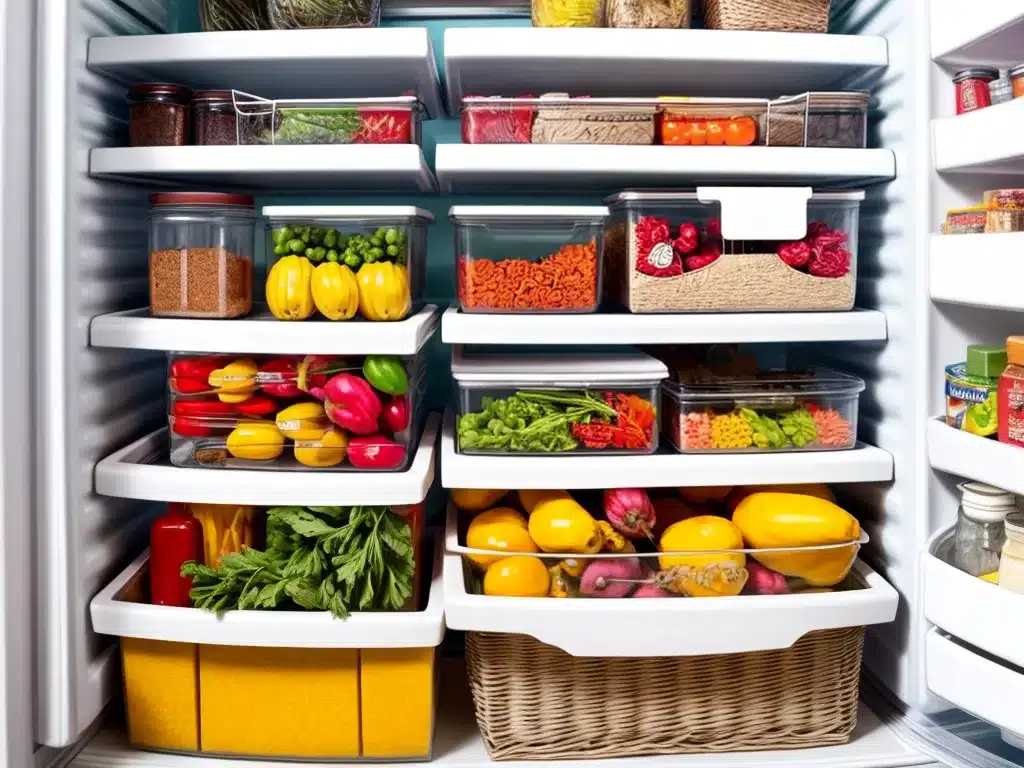Do a Thorough Cleaning First
Before I can organize my fridge and pantry for the new season, I need to thoroughly clean out both spaces first. This allows me to take stock of what I have and make room for the new foods I will be buying.
To clean the fridge, I remove all expired food and wipe down all shelves, drawers, and walls with a disinfecting cleaner. I scrub stubborn stains and spills to make sure no old odors linger. I clean the rubber gaskets around the doors to prevent harmful bacteria from collecting.
For the pantry, I take everything off the shelves and wipe them down. I check all packages for expiration dates and throw out anything past its prime. Pasta, rice, oats, baking mixes – I make sure they are sealed properly so no bugs or moisture gets in. I vacuum the shelves and floor to pick up crumbs and dust.
Once everything is sparkling clean, I’m ready to organize it all again with the seasons in mind.
Organize Fridge Contents Based on Frequency of Use
The fridge organization starts with grouping ingredients based on how often I use them. Things I use every day like milk, eggs, condiments, and leftovers go on the main shelves at eye level for easy access. Things I use a few times a week like cheese, yogurt, and juices go on the top shelves. Items I only use occasionally like broths, dressings, and jarred foods get grouped on the bottom shelves.
I keep all produce together in the crisper drawers, away from ethylene-producing fruits and vegetables that accelerate ripening. I store meats and fish on the lowest shelf or in a designated drawer to prevent juices from dripping onto other foods. The freezer gets divided into sections for frozen fruits and vegetables, ice cream, frozen meals, and meats.
This system ensures the items I need most frequently are front and center while less used items stay organized in their designated areas.
Shop Seasonally for Fresh Ingredients
When stocking my fridge and pantry in the spring, I try to shop for ingredients that are fresh and in season. Produce like asparagus, artichokes, peas, leafy greens, berries, and spring onions are plentiful now and full of flavor. I browse my local farmer’s market to find the best deals on spring fruits and veggies.
In-season spring proteins like lighter meats, shrimp, and halibut are also easy to find. I stock up on staples like eggs, yogurt, and cheese that use the extra milk supply from spring calving. I look for light, bright spices and herbs like dill, chives, mint, and parsley to spice up my spring dishes.
Buying in-season ingredients ensures I get the best price, flavor, and nutritional value. It also reduces the carbon footprint from transporting out-of-season foods long distances.
Store Foods Properly to Maximize Freshness
Now that I’ve filled my fridge and pantry with spring foods, proper storage is key to keeping them fresh as long as possible. Here are some of my best tips:
- Store fruits and vegetables in perforated bags – This allows air flow while still protecting from bruising.
- Keep berries in shallow, vented containers – The extra oxygen helps extend their shelf life.
- Wrap leafy greens loosely in paper towels before putting in bags -Absorbs excess moisture.
- Set fridge temp to 34-37°F – Colder than this can damage produce.
- Keep eggs in the carton – Minimizes air exposure and prevents absorption of odors.
- Wipe jars/cans before storage – Prevents pantry pest infestations.
- Keep similar food items together– Grouping like with like makes things easier to find.
Following these guidelines helps me enjoy all the delicious in-season ingredients to their fullest potential. Less food waste means more money savings!
Plan Meals and Snacks to Use What You Buy
The final step in my spring fridge and pantry organization is planning meals and snacks around what’s in stock. I browse my staples and make a list of all the dinner meals I can make with them – frittatas with veggies and cheese, pasta salads with tuna and veggies, veggie stir fries with tofu, etc.
I also think of quick snacks and appetizers utilizing my staples like smoothies with yogurt and berries or easy cheese boards with crackers, nuts, and seasonal fruits. For lunches, I plan to use up leftovers from dinners and incorporate fresh seasonal produce into sandwiches, wraps, and spring salads.
Planning like this helps me avoid letting any ingredients go to waste. I also save money by only buying more groceries as needed each week rather than over-purchasing. Getting in the habit of meal planning is a great way to transition my eating habits into the new season.
Conclusion
Organizing the fridge and pantry for spring means starting with a deep clean of both spaces, buying fresh in-season ingredients, storing items for maximum freshness, and planning meals to use what you have. Following this routine sets me up to make delicious spring dishes, reduce food waste, and save money on groceries. With a well-stocked and organized kitchen, I can fully embrace cooking with all the seasonal produce and flavors this time of year has to offer.







